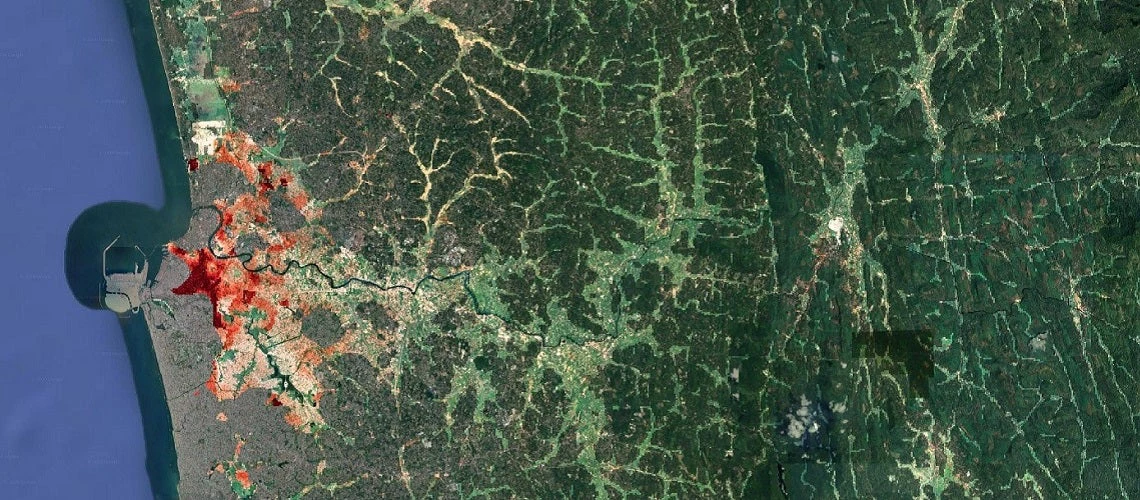 Carte de l’exposition aux risques d’inondation de Colombo (Sri Lanka)
Carte de l’exposition aux risques d’inondation de Colombo (Sri Lanka)
Flooding is one of the most common and severe hazards disrupting people’s lives and livelihoods around the world. Floods often cause unmitigated damage and suffering, especially in lower income countries where infrastructure systems – including drainage and flood protection – tend to be less developed. While countries at all levels of development face flood risk, the vast majority of the world’s flood exposed people – 89% – live in low- and middle- income countries. Critically, it is not only major, more infrequent floods, but also smaller, frequent events that can reverse years of progress in poverty reduction and development.
Using the latest high-resolution flood hazard and population maps, as well as poverty estimates from the World Bank’s Global Subnational Atlas of Poverty and Global Monitoring Database, we estimate that 1.47 billion people globally are directly exposed to the risk of intense flooding — over a third of them, almost 600 million, are poor.
Here are three key findings:
1. Around the world, exposure to flood risk is substantial.
Some 2.2 billion people, or 29% of the world population, live in locations that are estimated to experience some level of inundation during a 1-in-100-year flood event. Such an event has a 1% chance of occurring in any given year, which translates to a 10% probability in a decade, or 50% in a lifetime (68 years). About 1.47 billion people, or 19% of the world population, are directly exposed to inundation depths of over 0.15 meters. Furthermore, for over half of this exposed population, flooding could be even higher reaching life-threatening levels, especially for children and the disabled.
2. Flood risk is global, but East Asia and South Asia could see the worst of it.
Flood risk is a near universal threat: populations are not safe in any of the 189 countries examined. Yet, the sheer number of people in harm’s way is particularly large in South and East Asia. These regions are home to the majority of flood-exposed people, about 1.36 billion; with China (329 million) and India (225 million) alone accounting for over a third. This regional picture is explained by the fact that several large and densely populated areas are in high-risk flood zones, such as coastal areas or low-lying river plains (for instance along the Mekong, Brahmaputra, or Irrawaddy rivers).
3. When flood exposure and poverty coincide the risk to livelihoods are most severe.
The most devastating long-term consequences of floods are often experienced by the poorest households – those who have next to no savings and limited access to support systems. By considering the dimension of poverty, it is possible identify where floods would cause prolonged adverse impacts on livelihoods and well-being. By this measure, countries in sub-Saharan Africa face the greatest threat: We estimate that of the 171 million flood-exposed people in this region, at least 71 million people live in extreme poverty (i.e. living on less than $1.90 a day). Globally, 587 million poor people are exposed to flood risk, 132 million of which live in extreme poverty.
Critically, income level is a relatively reliable proxy for the ability of people to mitigate, cope with, and recover from floods. For instance, while a large share of the Dutch population lives in flood-risk areas, large-scale investments in flood protection infrastructure have enabled them to mitigate risks. Similarly, flood-exposed populations in Canada or Japan are more likely to have access to rapid government support systems in post-disaster situations compared to people in Malawi or Bangladesh. Thus, strengthening disaster prevention and recovery capacity is most urgently needed in the hotspots where poverty and flood exposure coincide.
Evolving risks require urgent action
Flood risks are constantly evolving. There is evidence that the process of coastal urbanization is accelerating the increase of flood risk. With safe areas already occupied, new settlements and developments are occurring increasingly in high-risk areas. As spatial planning and infrastructure investments (such as drainage systems) struggle to keep up with the pace of urbanization, risks build up and are locked in. In the coming years, land subsidence, rapid coastal urbanization and climate change could further increase flood risks. Several high-risk countries, such as Vietnam or Fiji, are now adopting comprehensive action plans to balance these risks and opportunities in order to safeguard development prospects for future generations.
Download the study: Rentschler, J., M. Salhab. 2020. People in Harm's Way: Flood Exposure and Poverty in 189 Countries. Policy Research Working Paper. No. 9447.
This study was supported by the Global Facility for Disaster Reduction and Recovery (GFDRR).



Join the Conversation